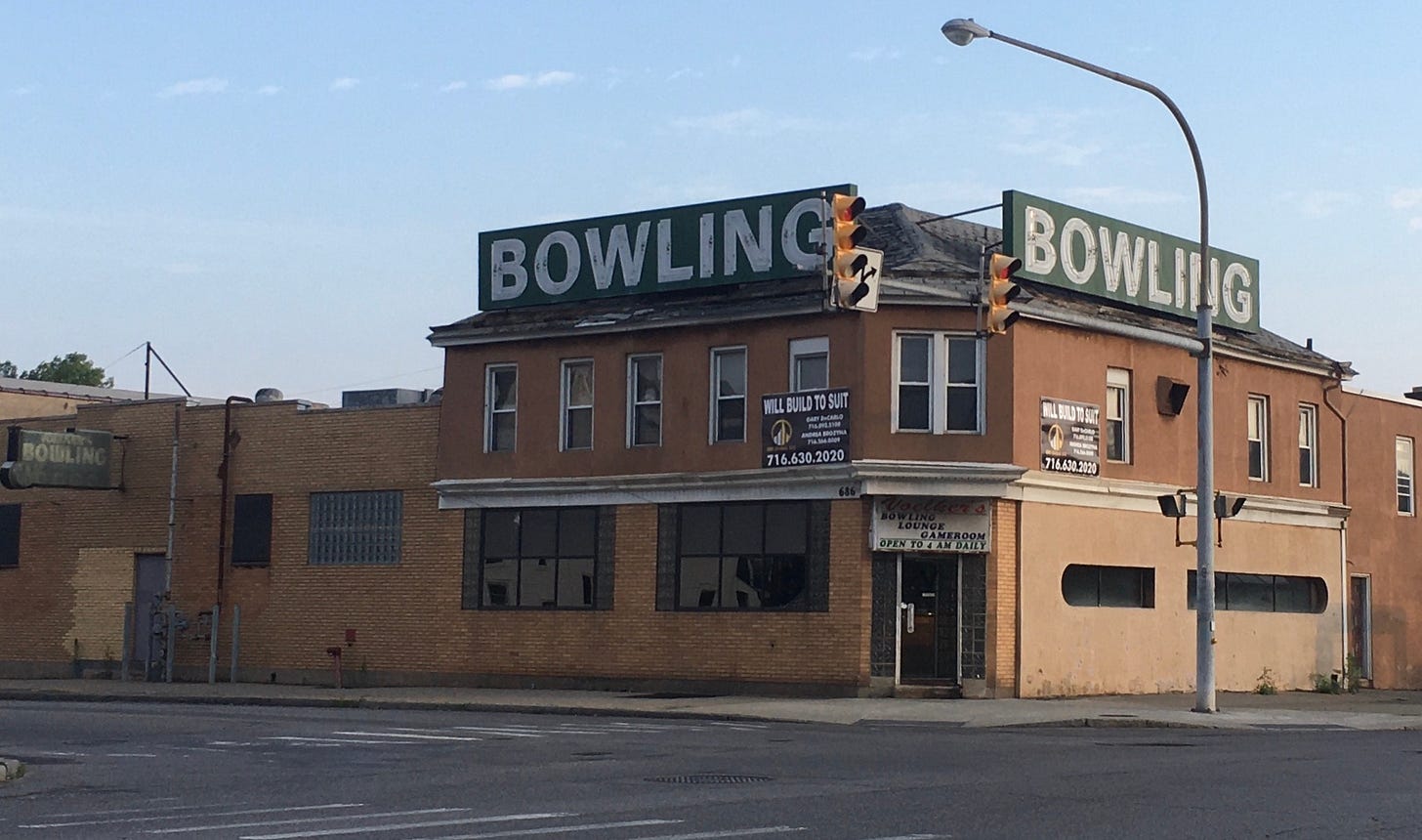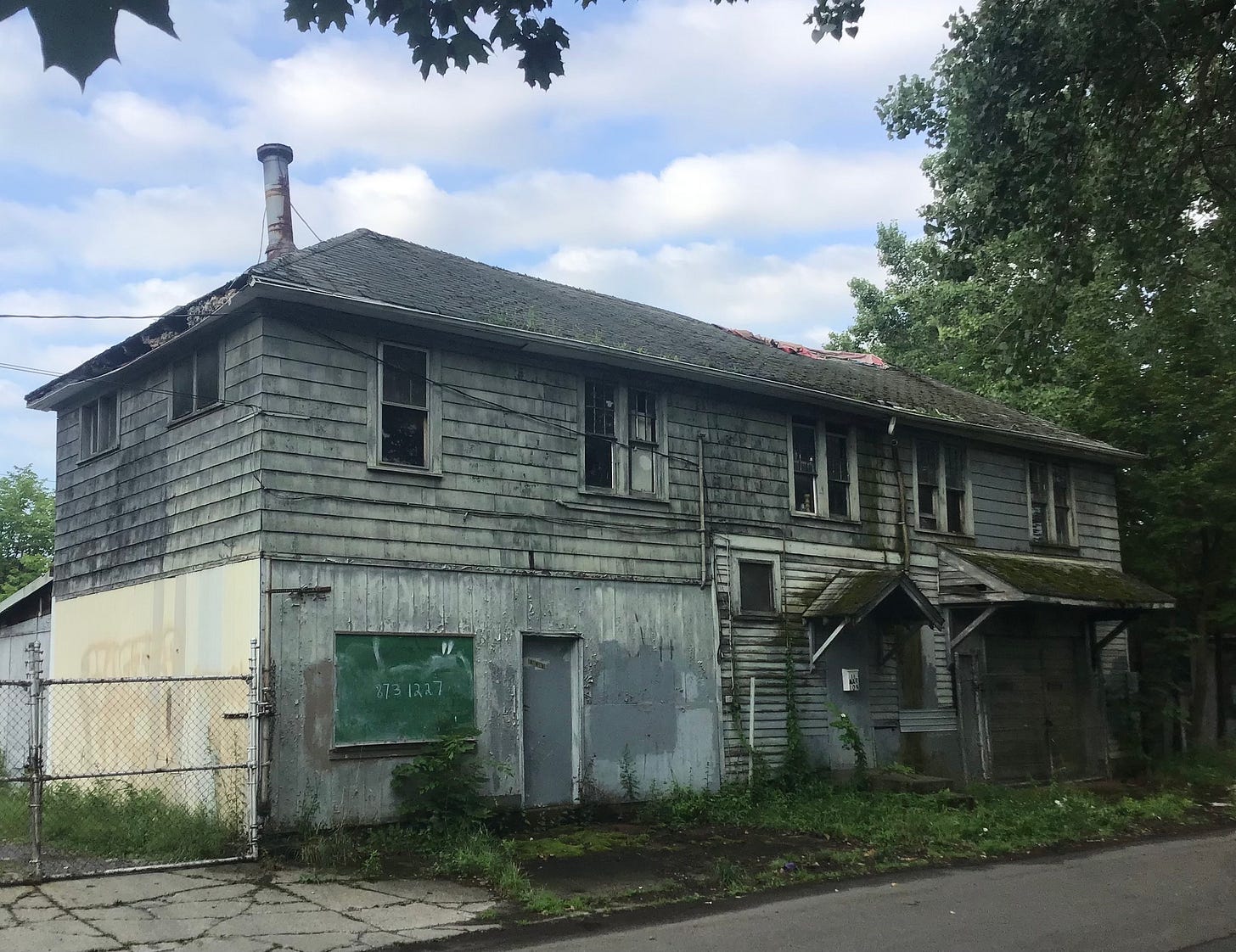Should a landmark be demolished and negligent owner rewarded?
Voelker's owner claims "terrible shape" of building under her ownership reason enough to deny landmark status and demo a Buffalo icon
The building known to generations of Western New Yorker’s as Voelker’s Lanes—a symbol of Buffalo in magazines, movies, and countless newspapers articles and web posts— is under threat of disappearing after an April demolition permit request by the owner and a seeming policy change by the Buffalo Preservation Board.
Upon reviewing the demo application, the Preservation Board moved to prepare a landmark application for the complex and asked for the Campaign for Greater Buffalo’s assistance. That application was the subject of a public hearing on June 24.
The Board did not vote on whether the application demonstrated that the building met the four stated criteria for landmarking (only one is necessary), it took the extraordinary step of allowing the applicant two weeks to collect documentation that “neighbors” were opposed to landmarking. It is against an administrative order of the Brown Administration for the Board to even consider future use of a building or site when rendering its judgement on landmark applications (the owner said it was the difference between having the site be “vacant and rotting” or a “green space,” despite the obvious commercial potential of the site driving the demolition application.
Incredibly, the owner testified that the building being in “terrible shape” justified its demolition and not landmarking it. This would be to reward a negligent owner. It would also be rewarding the Brown Administration’s lax building code enforcement. Krista Voelker inherited the building after her father’s 2008 death; the Brown Administration took office on January 1, 2006.

That means another chance for the public to weigh in on Thursday, July 8 at 3:00pm remotely. The Campaign urges the public to attend the videoconference and to speak.
The link is https://buffalony.webex.com/buffalony/j.php?MTID=mce68892520b84900536fb86956b4011d.
Correcting the Record
The Buffalo News, meanwhile, published an editorial pooh-poohing the notion that the Preservation Board should simply ignore its mandate and dismiss the findings of its own landmark application. The editorial was based on a June 28 story published in the News which itself had major errors and omissions.
That got a reaction from Campaign Chair and former long-time chair of the Buffalo Preservation Board, Paul McDonnell, who enumerated the problems in a July 6 letter to the News:
1) The editorial states that “the bowling alley has not seen bowlers for years.” I personally bowled there in January 2020, and New York’s executive order closing all places of public gathering occurred only on March 16, 2020. The June 28 article mentions the business “shut down permanently in early May,” making it unclear whether Voelker’s had a partial re-opening or simply threw in the towel after being closed for 14 months.
The editorial asserts that “there is decay.” As evidence, the editorial cites the owner as saying the building itself “falling down.” The article further stated that “The building's in terrible shape. Anybody can see that.” Indeed. Since Krista Voelker assumed ownership in 2008, no permits have been found for roofing work, electrical work, structural improvements—anything which would require conformance to city codes, save for a minor roof job in 2009. There aren’t any such permits long before that, either. In fact, the Voelker family has long owned a wooden two-story building on the site, on 111 Marion Street, which has simply been abandoned and is now in an advanced state of decay.
All the deterioration of the building occurred under the present ownership. It is their responsibility to maintain the building in good condition just like any other citizen. If the building has deteriorated aesthetically or structurally that is also negligence on the part of the city Department of Permits and Inspection services.
We have just seen a collapse of a building on Oak Street on Friday, and recently another on Ellicott Street, due to the same circumstances of owner neglect and lax code enforcement. This hurts the general welfare of the city.
There is also an assertion by the owner repeated by the Buffalo news that Voelker “wants to leave the land open for green space” that has never been believed by observers, and is belied by signs on the building indicating it is available to “build to suit.”
There is an assertion that forcing an owner to maintain a building is an “unfunded and unjustifiable mandate.” All manner of property mandates are “unfunded”— electrical and plumbing systems, lawn maintenance, setbacks and lot coverage, structural integrity, emissions of noise, light, effluent, and runoff, for example. These are to enforce community standards and advance public welfare.
The qualifier of “unjustifiable” requires an examination of the landmark application that the Preservation Board is considering. Yet no discussion of that appeared in the News article or the editorial based on it. Rather, any evidence is simply dismissed with the notion that there is “thin evidence that anything is left to preserve.” On the contrary, as the application amply shows, the original building of c1886 and a hotel addition dating to 1898 still exist and can readily be seen to anyone on the ground or viewing an aerial imagery and consulting the chronology in the landmark application.
This editorial assertion may be based on quotations from the business owner in the June 28 article that were simply stated without the context that those same characterizations were refuted at the hearing. To wit:
“I disagree with some of their opinions about the landmark stuff," Voelker said. "Some of the things they presented I find factually incorrect, considering that my family has been on the corner for 120 years.” The article did not mention what facts the owner is challenging, the validity of each challenge to historical fact. It seeks to confer expertise by mere presence on the property.
“She noted that the hotel rooms have been gone for 50 years – razed to make room for the front parking lot.” As previously noted, this is belied by evidence presented in the application and rebutted immediately at the hearing.
The role of Preservation Board under City Code
McDonnell went on to explain the role that the Preservation Board plays as the body authorized to investigate buildings proposed to be demolished in Buffalo. “The Preservation Board makes a recommendation based on it’s expertise given in the city code. It then sends the application and recommendation to the Buffalo Common Council, which would then vote on whether the site should be designated an official landmark. Further, it would be up to the Department of Permits and Inspection Services whether to grant a demolition permit under emergency circumstances, with mandated consultation with the Preservation Board, which may intervene.
“Lastly, it must be noted that the Preservation Board is prohibited by a 2008 administrative order of the Brown administration from considering future use and condition of a site when weighing denial of a demolition permit, and required to issue a report of findings of fact to support its decision. A landmark application serves that purpose. (The relevant section states “ The Office of Strategic Planning/Preservation Board shall restrict its reviews, findings, decisions and recommendations to preservation matters only. Future use of the property, impact on the streetscape, future aesthetics of the area, vehicular and pedestrian impacts and similar matters shall not be considered.”)
This is to protect the public, ensuring that the Board’s decisions are objectively based on criteria established in the City Code, and whether the site meets any one of nine possible criteria for landmark designation. The Voelker’s application states the site meets not one, but four criteria for listing as a City of Buffalo landmark.
“All of this is to protect an economic, social, and marketing resource — Buffalo’s historic structures. This can be seen two blocks away in Black Rock where previously forlorn and neglected industrial structures have been brilliantly rehabilitated into hotels, offices, housing, and restaurants along the Belt Line between Elmwood Avenue and Military Road.
“The Preservation Board is the properly constituted authority to weigh the historic, architectural, and cultural aspects of a given structure or site and to make a recommendation to the city’s legislative body to protect that heritage. That process should be allowed to run its proper course.”
McDonnell closed with the words of Steve Cichon, in Buffalo Stories, published in the online edition of the News on November 2017.
“They were shooting a movie in front of Voelker’s, because that is what attracts people to Buffalo. WNY is real, authentic, and lived in.
“Progress is good and we need it– but we also need to keep in mind what draws people here.
“In a word, it’s our soul. The soul that lives in us and the soul that lives as part of our streetscape and buildings.
“If something new is going to take away from that soul, it had better bring something tangibly more to the community.
“Protecting soul can’t be written into a zoning plan. We have to be stewards of the essence that makes us who we are, and as a community, we need to continue to talk about all the Buffalo intangibles that money can’t buy– but sure as hell can ruin.”






Another carefully-researched and beautifully-written piece by the CGB! Great work! Very convincing.